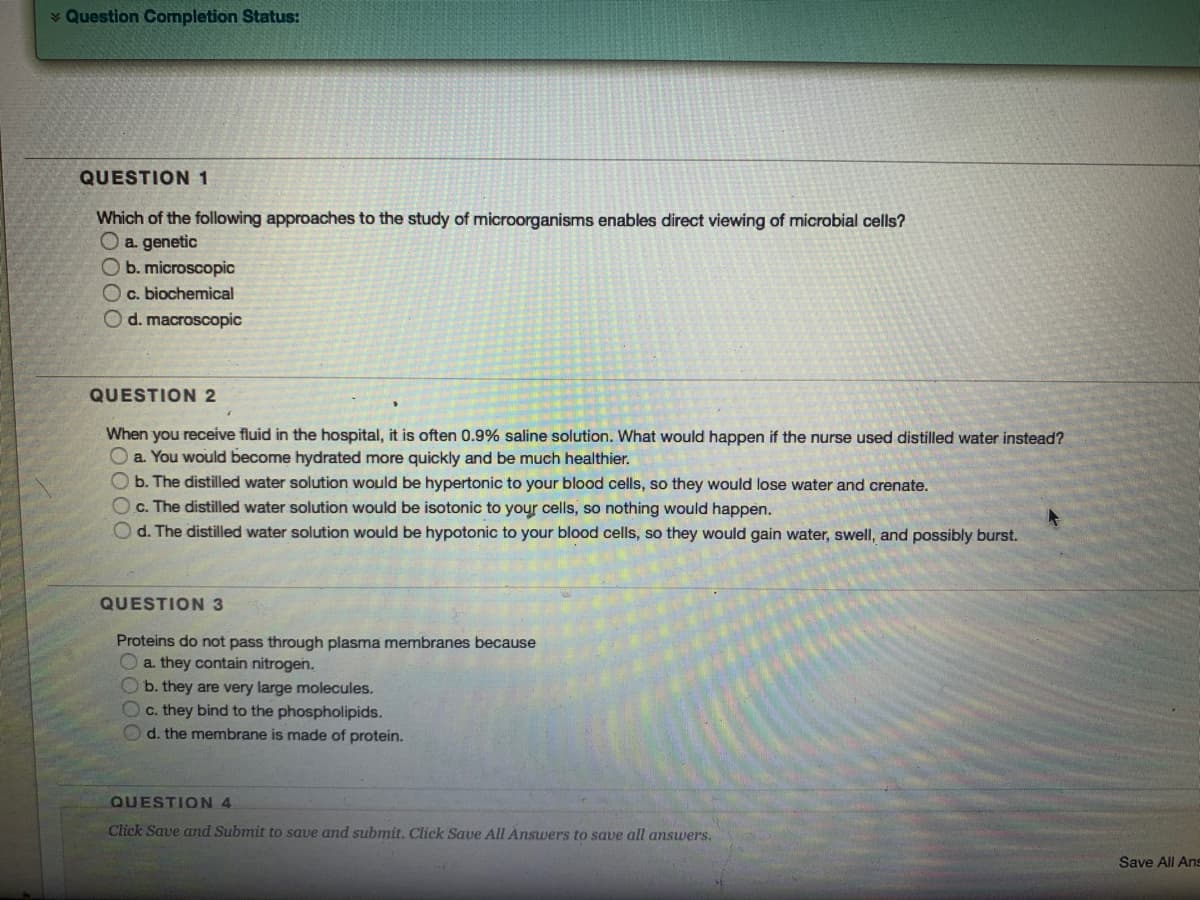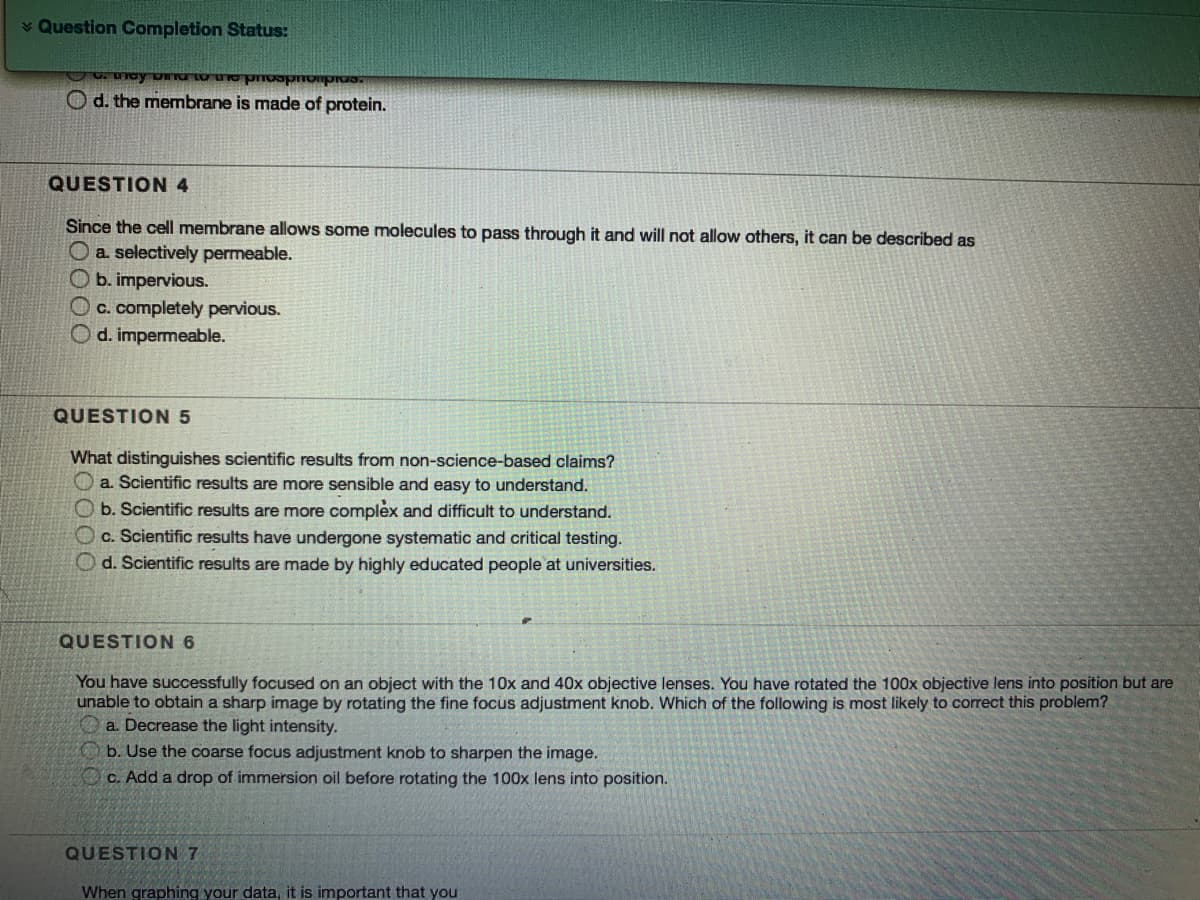UESTION 1 Which of the following approaches to the study of microorganisms enables direct viewing of microbial cells? Oa genetic Ob. microscopic O c. biochemical Od. macroscopic QUESTION 2 When you receive fluid in the hospital, it is often 0.9% saline solution. What would happen if the nurse used distilled water instead? a. You would become hydrated more quickly and be much healthier. b. The distilled water solution would be hypertonic to your blood cells, so they would lose water and crenate. c. The distilled water solution would be isotonic to your cells, so nothing would happen. Od. The distilled water solution would be hypotonic to your blood cells, so they would gain water, swell, and possibly burst. QUESTION 3 Proteins do not pass through plasma membranes because O a they contain nitrogen. b. they are very large molecules. c. they bind to the phospholipids. O d. the membrane is made of protein.
UESTION 1 Which of the following approaches to the study of microorganisms enables direct viewing of microbial cells? Oa genetic Ob. microscopic O c. biochemical Od. macroscopic QUESTION 2 When you receive fluid in the hospital, it is often 0.9% saline solution. What would happen if the nurse used distilled water instead? a. You would become hydrated more quickly and be much healthier. b. The distilled water solution would be hypertonic to your blood cells, so they would lose water and crenate. c. The distilled water solution would be isotonic to your cells, so nothing would happen. Od. The distilled water solution would be hypotonic to your blood cells, so they would gain water, swell, and possibly burst. QUESTION 3 Proteins do not pass through plasma membranes because O a they contain nitrogen. b. they are very large molecules. c. they bind to the phospholipids. O d. the membrane is made of protein.
Microbiology for Surgical Technologists (MindTap Course List)
2nd Edition
ISBN:9781111306663
Author:Margaret Rodriguez, Paul Price
Publisher:Margaret Rodriguez, Paul Price
Chapter3: The Microbiology Laboratory
Section: Chapter Questions
Problem 4TBP
Related questions
Question

Transcribed Image Text:* Question Completion Status:
QUESTION1
Which of the following approaches to the study of microorganisms enables direct viewing of microbial cells?
Oa genetic
Ob. microscopic
O c. biochemical
O d. macroscopic
QUESTION 2
When you receive fluid in the hospital, it is often 0.9% saline solution. What would happen if the nurse used distilled water instead?
a. You would become hydrated more quickly and be much healthier.
O b. The distilled water solution would be hypertonic to your blood cells, so they would lose water and crenate.
c. The distilled water solution would be isotonic to your cells, so nothing would happen.
d. The distilled water solution would be hypotonic to your blood cells, so they would gain water, swell, and possibly burst.
QUESTION 3
Proteins do not pass through plasma membranes because
a. they contain nitrogen.
b. they are very large molecules.
Oc. they bind to the phospholipids.
d. the membrane is made of protein.
QUESTION 4
Click Save and Submit to save and submit. Click Save All Answers to save all answers.
Save All Ans

Transcribed Image Text:Question Completion Status:
O d. the membrane is made of protein.
QUESTION 4
Since the cell membrane allows some molecules to pass through it and will not allow others, it can be described as
Oa. selectively permeable.
Ob. impervious.
OC. completely pervious.
O d. impermeable.
QUESTION 5
What distinguishes scientific results from non-science-based claims?
O a. Scientific results are more sensible and easy to understand.
O b. Scientific results are more complex and difficult to understand.
Oc. Scientific results have undergone systematic and critical testing.
O d. Scientific results are made by highly educated people at universities.
QUESTION 6
You have successfully focused on an object with the 10x and 40x objective lenses. You have rotated the 100x objective lens into position but are
unable to obtain a sharp image by rotating the fine focus adjustment knob. Which of the following is most likely to correct this problem?
a. Decrease the light intensity.
b. Use the coarse focus adjustment knob to sharpen the image.
Oc. Add a drop of immersion oil before rotating the 100x lens into position.
QUESTION 7
When graphing your data, it is important that you
Expert Solution
This question has been solved!
Explore an expertly crafted, step-by-step solution for a thorough understanding of key concepts.
This is a popular solution!
Trending now
This is a popular solution!
Step by step
Solved in 2 steps

Knowledge Booster
Learn more about
Need a deep-dive on the concept behind this application? Look no further. Learn more about this topic, biology and related others by exploring similar questions and additional content below.Recommended textbooks for you

Microbiology for Surgical Technologists (MindTap …
Biology
ISBN:
9781111306663
Author:
Margaret Rodriguez, Paul Price
Publisher:
Cengage Learning



Microbiology for Surgical Technologists (MindTap …
Biology
ISBN:
9781111306663
Author:
Margaret Rodriguez, Paul Price
Publisher:
Cengage Learning

